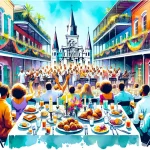Situated in the heart of Uptown New Orleans, Freret Street has emerged as an enticing culinary and cultural destination, captivating locals and visitors with its diverse blend of restaurants, shops, and community events. This once-neglected area has undergone a remarkable revival, becoming a shining example of urban rejuvenation and a testament to the resilience of the New Orleans spirit.
In This Article
TL;DR
- Freret Street’s transformation into a lively urban space with a thriving food scene.
- The unique fusion of historical architecture and modern businesses.
- Community and cultural events that define the street’s distinctive character.
Historical Overview of Freret Street
Freret Street’s origins date back to the late 19th century when it served as a bustling commercial corridor for the surrounding neighborhoods. However, like many urban areas across the country, Freret Street fell into decline in the latter half of the 20th century. Vacant storefronts and dilapidated buildings became a common sight, and the once-thriving street seemed destined for obscurity.
But in the early 2000s, a group of dedicated community members and local entrepreneurs recognized the potential in Freret Street’s unique character and historical significance. They banded together to launch a revitalization effort, working tirelessly to attract new businesses, restore historic buildings, and create a welcoming environment for residents and visitors alike.
Thanks to their efforts, Freret Street has undergone a remarkable transformation in recent years. The street is now home to a variety of restaurants, bars, shops, and cultural venues, each contributing to the area’s vibrant and eclectic atmosphere. The revitalization of Freret Street stands as a testament to the power of community involvement and the enduring spirit of New Orleans.
Culinary Delights on Freret Street
One of the driving forces behind Freret Street’s renaissance has been its burgeoning food scene. The street is now home to an impressive array of restaurants and eateries, each offering its own unique take on New Orleans cuisine and beyond.
One standout is High Hat Cafe (4500 Freret St.), a casual neighborhood spot that specializes in Southern and Louisiana staples like catfish, Gulf seafood, and slow-roasted pork. Don’t miss their signature pimento cheese, which makes an appearance in dishes like the house burger, specialty fries, and deviled eggs.
For a more upscale dining experience, head to Bar Frances (4525 Freret St.), a contemporary bistro known for its extensive selection of natural wines and seasonal small plates. The airy, inviting space is perfect for a leisurely meal with friends or a romantic dinner for two.
No visit to Freret Street would be complete without a stop at Dat Dog (5030 Freret St.), a colorful, all-ages beer garden that serves up creative hot dogs, sausages, and more. With toppings ranging from crawfish étouffée to blackberry sauce, there’s a dog for every taste. Vegans and vegetarians will appreciate the plant-based sausage options.
Other notable eateries on Freret Street include The Company Burger (4600 Freret St.) for award-winning burgers and shakes, Mint Modern Vietnamese Bistro & Bar (5100 Freret St.) for pho and banh mi with modern twists, and Ancora Pizzeria (4508 Freret St.) for obsessively crafted Neapolitan pies.
Architectural Charm and Design
In addition to its culinary offerings, Freret Street is known for its stunning historical architecture. Many of the buildings along the street date back to the late 19th and early 20th centuries, with styles ranging from Italianate to Craftsman.
As part of the revitalization effort, many of these historic structures have been carefully restored and adapted for modern use. The result is a charming streetscape that seamlessly blends old and new, with colorful storefronts and inviting facades that beckon visitors to explore.
One notable example is the Cadiz Street Market (4301 Freret St.), a former grocery store that has been transformed into a mixed-use development featuring apartments, retail spaces, and a popular food hall. The building’s original architectural details, such as its pressed-tin ceilings and exposed brick walls, have been preserved and incorporated into the new design.
Cultural and Community Events
Freret Street is more than just a destination for food and shopping; it’s also a hub for community and cultural events that bring the neighborhood together.
One of the most anticipated events of the year is the Freret Street Festival, a free, one-day celebration of art, music, and food that takes place each spring. The festival features live performances by local musicians, an art market showcasing the work of New Orleans artists, and food vendors serving up classic New Orleans dishes and international fare. The 2024 festival is scheduled for March 30 from 11 a.m. to 6 p.m., spanning Freret Street from Napoleon to Valmont.
Other popular events include the Freret Market, a monthly outdoor market featuring local vendors, live music, and food trucks, and the Freret Publiq House Trivia Night, a weekly trivia competition that draws crowds of locals to test their knowledge and enjoy craft beers and cocktails.
These events not only provide entertainment and a sense of community for residents, but they also help to support local businesses by drawing visitors to the area.
Shopping and Local Businesses
In addition to its restaurants and bars, Freret Street is home to a variety of unique shops and boutiques that offer a taste of New Orleans culture and creativity.
One standout is Freret Street Po-Boys & Donuts (4701 Freret St.), a beloved local spot that serves up classic New Orleans sandwiches and creative donut flavors like king cake and crawfish étouffée. The shop has been featured on national television shows like “Diners, Drive-Ins, and Dives” and has become a must-visit destination for foodies and locals alike.
Other notable shops include Defend New Orleans (4207 Freret St.), a locally owned apparel and accessories brand that celebrates the city’s unique culture and resilience, and Crescent City Comics (4529 Freret St.), a comic book store that hosts regular events and signings with artists and writers.
Many of the businesses on Freret Street are owned and operated by local entrepreneurs who are passionate about their community and committed to its success. By supporting these small businesses, visitors can help to ensure that Freret Street remains a vibrant and thriving part of the New Orleans landscape.
Nightlife and Entertainment
When the sun goes down, Freret Street comes alive with a vibrant nightlife scene that offers something for everyone.
One of the most popular spots is Gasa Gasa (4920 Freret St.), a live music venue and art gallery that hosts a diverse lineup of local and touring acts. With its intimate setting and eclectic decor, Gasa Gasa has become a favorite among music lovers and artists alike.
For a more laid-back vibe, head to Cure (4905 Freret St.), a craft cocktail bar that has been credited with helping to kickstart the city’s mixology renaissance. The bar’s knowledgeable staff and inventive drink menu have earned it national acclaim, including a James Beard Award nomination for Outstanding Bar Program.
Other notable nightlife spots on Freret Street include The Other Bar (5039 Freret St.), a dive bar with a loyal following and regular open mic nights, and The Publiq House (4528 Freret St.), a neighborhood tavern that offers live music, trivia nights, and a rotating selection of craft beers on tap.
Practical Information for Visitors
If you’re planning a visit to Freret Street, there are a few things to keep in mind to make the most of your experience.
The best times to visit depend on your interests. For dining, many restaurants offer lunch and dinner service, with brunch available on weekends. For shopping, most boutiques and shops are open during standard business hours, with some staying open later on weekends. If you’re interested in attending a specific event, be sure to check the schedule in advance and plan accordingly.
Parking can be a challenge on Freret Street, especially during peak hours and events. Many businesses offer limited parking in adjacent lots or on side streets, but visitors may need to park a few blocks away and walk. Alternatively, consider taking public transportation or a ride-sharing service to avoid the hassle of parking.
To make the most of your visit, come with an open mind and a willingness to explore. Take a stroll down the street and pop into shops and restaurants that catch your eye. Strike up a conversation with a local business owner or fellow visitor. And above all, take the time to savor the unique flavors, sights, and sounds that make Freret Street such a special part of New Orleans.
Sustainability and Community Initiatives
As Freret Street continues to grow and evolve, local businesses and community organizations are working to ensure that the area remains a sustainable and equitable place to live, work, and visit.
Many businesses on the street have implemented eco-friendly practices, such as using biodegradable packaging, sourcing ingredients from local farms, and reducing waste through composting and recycling programs. Some, like Mojo Coffee House (4700 Freret St.), even offer discounts to customers who bring their own reusable cups.
Community organizations like the Freret Neighborhood Center and the Freret Business and Property Owners Association are also working to address issues like affordable housing, public safety, and access to green space. Through initiatives like the Freret Corridor Zoning Overlay, which encourages mixed-use development and pedestrian-friendly design, these groups are helping to ensure that Freret Street remains a vibrant and inclusive community for years to come.
As a visitor to Freret Street, you can support these efforts by patronizing local businesses, attending community events, and learning more about the history and culture of the area. By doing so, you’ll not only have a more meaningful and authentic experience, but you’ll also be contributing to the ongoing revitalization and resilience of this unique and beloved New Orleans neighborhood.






